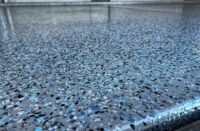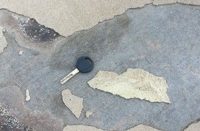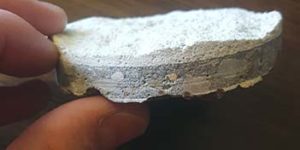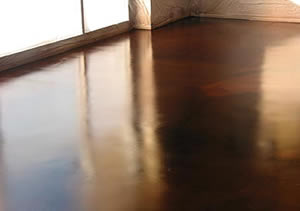 Moisture management… and a whole lot more.
Moisture management… and a whole lot more.
In a perfect world, moisture intrusion wouldn’t be a problem for any concrete floor. Unfortunately, even when all the proper steps are taken before the concrete is poured, moisture issues can come up. If moisture is the only challenge you’re facing, there are many products you can choose to combat it, such as topical sealers and crystalline waterproofing products. But if you’re trying to achieve multiple objectives — including moisture management — with just one product, a densifier may be just the thing you’re looking for.
When talking about densifiers, it is important to be clear about what a densifier is, and what it is not. It is not a moisture-proofer or a waterproofer or a water repellant.
Steve Erickson, president of DynaCrete USA, reports that waterproofing materials are often confused with densifiers. They are also confused with wear coats, he adds.
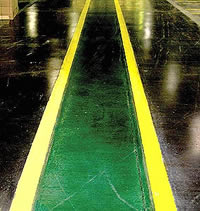 Rather than being products that plug off the naturally occurring capillaries in the surface of concrete, densifiers penetrate and become part of the concrete matrix. They are more than a membrane or topical sealer.
Rather than being products that plug off the naturally occurring capillaries in the surface of concrete, densifiers penetrate and become part of the concrete matrix. They are more than a membrane or topical sealer.
As Phil Smith, vice president and technical director of L&M Construction Chemicals Inc., explains, 15 percent to 20 percent of portland cement forms calcium hydroxide as a by-product of the hydration process. This by-product is soft and does not contribute to the structural integrity of the concrete, so the idea behind densifiers “is to take this material that has no structural value and marry it to a chemical substance that can convert it into a material that has structural value.”
Densifiers penetrate into concrete, then chemically react with the calcium hydroxide within the surface of the concrete. This chemical interaction creates yet another by-product that fills and closes the pores in the concrete, thereby producing a denser surface.
It’s this reduced porosity in the concrete that slows moisture penetration, says Jim Sist, president of ChemTec International Inc. It also does much more, but we’ll get to that shortly.
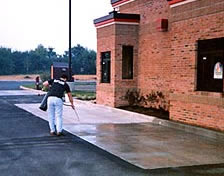 Erickson observes that the chemical reaction stimulated by densifiers will stop only if the densifier runs out of alkali (calcium hydroxide) or if the job is complete. Or, the densifier may run out before you reach the desired penetration.
Erickson observes that the chemical reaction stimulated by densifiers will stop only if the densifier runs out of alkali (calcium hydroxide) or if the job is complete. Or, the densifier may run out before you reach the desired penetration.
Other beneficial characteristics of densifiers
Densifiers have many more benefits than simply decreasing moisture penetration: They increase abrasion resistance, stop wear and dusting, and generally have a high resistance to acidic materials such as salts, solvents and mild acids. “They do protect the cementitious property of the concrete and maintain a high pH for a prolonged period, thereby extending the useful life of the structure,” Sist says.
Other industry experts agree that densifiers produce many beneficial characteristics for concrete surfaces.
Erickson reports densifiers can dramatically increase the compressive strength of concrete — “especially the older it gets” — and also improve tensile strength.
The change in the molecular structure of the concrete is permanent. This has great appeal for large retail and industrial applications because denser, abrasion-resistant concrete is easy to maintain and has such a long life. If maintained properly — i.e., cleaned regularly — densified concrete should last decades.
Even in residential applications such as driveways and patios, densifiers have their advantages. For example, they help prolong concrete’s life when placed in freeze-thaw environments because they provide moisture control and resistance to salts and chemicals.
It’s important to understand, though, that densifiers do not create an impermeable surface. While densifiers block larger moisture molecules, they do breathe, allowing smaller air molecules to pass.
Densifiers are easy to apply
Densifiers work on new and old concrete, and they are easy to apply. Most often they are applied with a sprayer. Some product manufacturers recommend that the densifier be worked into the surface, with either a squeegee or a broom.
New concrete does not require any special preparation. Existing concrete should be cleaned and stripped of old coatings, such as sealers or paint.
Instructions for the use of different densifiers, including specific temperature and environmental parameters, can always be found on a product’s label and should be read and understood before application.
When is the best time to apply a densifier? Recommendations vary among manufacturers.
Erickson says to spray densifier on the concrete “as soon as you can walk on it or you pull the frames from the wall.”
Sist, also, recommends that densifiers be applied after the concrete has been placed and is hard enough to walk on without marking, or anytime after.
On the other hand, Smith suggests waiting. “We want to wait until the concrete has some age to it; at least four to seven days.” He explains that as hydration of the concrete continues, calcium hydroxide continues to be created. So, if you wait, there will be more calcium hydroxide for the chemical reaction. In addition, if you apply the densifier too soon, many of the pores in the concrete will still be filled with free water, limiting the empty capillaries available for the densifier to work into. In normal conditions, by day seven, concrete hydration is about 60 percent to 65 percent complete.
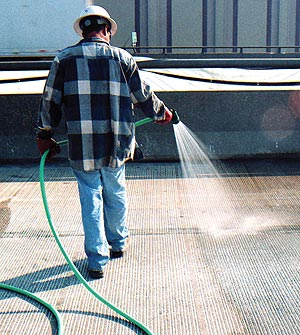 Fortunately, densifiers do not require much downtime. Sist says you can use the surface as soon as the treatment is installed and has dried, usually several hours.
Fortunately, densifiers do not require much downtime. Sist says you can use the surface as soon as the treatment is installed and has dried, usually several hours.
Nonetheless, the chemical reaction of the densifier and the calcium hydroxide continues for some time. Erickson reports the chemical process may continue for six months to a year. And the more densifier that goes through the chemical process, the denser and harder the surface.
Densifiers and decorative concrete
Depending on whom you talk to, you may get a different response regarding how densifiers work with decorative concrete, so it may be best to do a test first in an inconspicuous location.
A densifier may see pigment in integrally colored concrete as a contaminant, Erickson says, and try to push it to the surface, creating a splotchy effect.
Sist, on the other hand, reports that densifiers generally work well with integrally colored concrete. It’s acid stains you might have a problem with, he says. And he cautions, “If you use a densifier over an acid-stained slab, make sure you know to prep the concrete or you will ruin the stain.”
Erickson agrees that using densifiers with acid stains is tricky. “You may get some weird colors and results.”
With water-based stains, Smith recommends putting the stain down first, then densifying.
There generally are no problems in applying a densifier and then a cementitious topping, but experts vary on why you should or should not. Erickson suggests a densifier will “even out the substrate’s porosity” and enhance bonding. Smith observes that densifiers are designed to be used on wear surfaces and may eliminate the tooth of the surface.
Choosing a densifier
Sist points out that densifier manufacturers generally use sodium, potassium or lithium silicate as a base for their densifiers, and that they basically all work the same way. But each manufacturer has its own proprietary chemical blends, and there are a lot of variants among manufacturers and a lot of variants in performance.
That’s why it’s important, says Erickson, that a contractor understands what characteristics are required for the finished concrete. Knowing the specifications for each project will help you make a prudent choice in densifier product.
“Make sure that the manufacturer can supply you with lab testing backing up its claims of performance certified by a testing laboratory or engineering firm,” Sist says. “This will give [you] a sound basis to make [a] decision.”
ASTM standards are the most widely recognized, but other organizations — such as ACI and ASCC, even state departments of transportation — also have some standards or criteria for such products. For densifiers, testing parameters include abrasion resistance, depth of penetration, compressive strength, tensile strength, chloride ingress, permeability, water penetration, and the like.
Not all organizations test for all characteristics, and standards vary, of course. What you are more likely to encounter is a project description that includes required standards specified by the project architect, engineer or consultant. Find a densifier that meets the specified criteria and you should be good to go.
